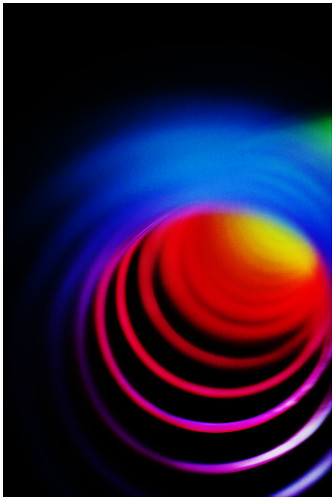Because we are only tenuously connected to the ‘outside world’ – there are many more interconnections within our brains than between our brains and our sensory organs – it should not surprise us that our ‘inner worlds’ can be this way.
Naturally-selected-for tuning to only a tiny fraction of the electromagnetic spectrum limits humans (and all other animals) to what biologist Jakob von Uexküll termed the umwelt (‘environment’) of our senses. While kit, scope and specialisation vary between lifeforms, all biological sensoria (‘sensory apparatus’) are electromagnetically narrowband.
Humans, however, face the added bandwidth-limiting problem of reflexive consciousness. So busy are our neurons (particularly our neocortical ones) compounding existing interconnections in their ‘fire together, wire together’ enthusiasm for group hugging that they sometimes render us almost insensate. Lost in our own incessant, jabbering narratives, real-time attention becomes subsumed, often only arising when called upon by our instinctive ‘lizard brain’ alert mechanisms.
Neuroscientist Sam Harris discusses this subject in his 2012 Edge essay ‘We are Lost in Thought’. Harris calls the private narrative ‘discursive thought’; you are engaged in a constant tête-à-tête with somebody who is not present:
When I say ‘not present’, I mean it in two senses: in the sense that neither participant in the discussion exists and in the sense that you are in not ‘in the moment’ while engaged in it. As Harris points out in his essay, detached, discursive thought is immensely useful for planning ahead, for learning, for abstract reasoning and for driving a host of other human cognitive functions. Nevertheless, the consequences of failure to see the wood of the here and now for the ramifying scrub of reverie and figment – and of failure even to recognize the scrub as scrub – can be severe. Harris identifies it as ‘a primary source of human suffering and confusion’.
We should not assume that thinking in a particular mode is a good thing – for us, for others, for our world – just because we happen ‘naturally’ to think in that mode. Unmanaged, rampant scrub-thought grows a painfully knotted self. Although ostensibly a gentle tool, mindfulness may act as machete.
Tweaking our minds with tailored attention is useful and important, but it only works when we recognise the self for what it is – a construct, a con-struct. In this world all too often influenced by horribly ramified selves, we are conned into believing that that is the way to be. What a sad joke! The obsessive hoarder of money, power, celebrity or other hollow abstracts is a monomaniac. He is not unthinking, he is over-and-over-and-over-thinking hopelessly constricted and shallow fancies.
At the other end of the scale, deep thinkers may stultify their minds with thoughts prodigious but dreadfully self-injurious. Inward and inward they go, mourning countless losses as glimpses of states of mind less brooding, less burning slip away from them again and again. Behold the void of melancholia – the singularity of mental suffering.
Some use religious contemplation, trusting prayer to lift what Harris calls ‘the veil of discursivity’. But far too often religionistic brooding births a monstrous super-self. The product of fantastical scrub-thought, this impossibly dual thing grovels tiny on its knees yet stands tall and wide enough to blot out the sun, the stars, the past, the future and all the multi-layered cynosure of the cosmos. Enchained by myth and custom, the religious super-self froths, rolls its eyes and snaps wildly at empty air. Feed it at your peril.
To a greater or lesser extent, we are all confused and suffering. Taking a scientific view and learning about neurological processes may not free you from mental anguish, but it will provide you with new schemata for understanding it. Switching schema from time to time allows you to break the discursive flow, if only tempor... the last ten min… negative thoughts about her because she told another friend that I was treating her with contempt by assuming that he’s obsessed with... shallow... mortgage... roof tiles... that paint... wrinkles... ugly... car... spiteful bitc... she said... blood... inadequate... Whoa! Whoa! wHoA! Where did that come from? What was its genesis? THE. THE. THE. Physical things in physical brain. Connections, neurochemistry, plasticity, recursive loops, negotiable loops, building my brain, building my brain.
I cannot adequately represent this schema-switching in words. But you will know it when you think it. Find your technique. Learn to drag yourself free of your own mental mire. At stake is your equilibrium, your happiness, your life and the lives of others.
Would a scientist creating a human-equivalent brain from scratch (let us call it a positronic brain) design it to expend most of its processing power on discursive thought? Probably not. It is likely that some level of reflexive, self-reinforcing thought would contribute positively to this synthetic brain’s operation as a human-equivalent one. Nevertheless, without safeguards against predominating levels of such thought this positronic brain might go swiftly negatronic – kernel panics, buffer overflows and system crashes might blight its operation to such an extent as to render it dysfunctional.
You do not design your brain from scratch. It is what it is – naturally-selected-for, biological, chemoelectrical, unfathomably complex. But you do get to intervene in its ongoing development. Although the concept of neuroplasticity is now widely discussed (but also, unfortunately, widely abused), it is still immensely difficult to get across to people that they have some measure of control over their thought-flow, and therefore, over the physical configuration of their brains. Why should this be? We accept readily the idea that learning can restructure our brains, but many resist the idea that discursive thought – our messy, meandering self-narratives – can too.
I think, perhaps, that notion is too raw for some – too visceral, too meaty and too demanding of a response. And at the same time, it is desperately abstruse – there’s nobody and nothing to respond to. As a pragmatic reductionist, however, I find it oddly reassuring. Although no inner friend exists in your mind to provide succour (and conversations with such a ‘friend’ would only compound the problem), self-correcting quasi-interventions are possible: mindfulness, schema-switching, intense pain (perhaps best avoided), empathetic face-to-face conversation. Carefully-controlled chemical intervention may work also, if that is your thing.
This is all that each of us has in this wide world – this tenuous connection to reality, this oft-distorted hall of mirrors that we call ‘mind’. That is a brutal truth, but also an empowering one. Tangled scrub-thought need not be our primary mode. Can we learn to hack it?




